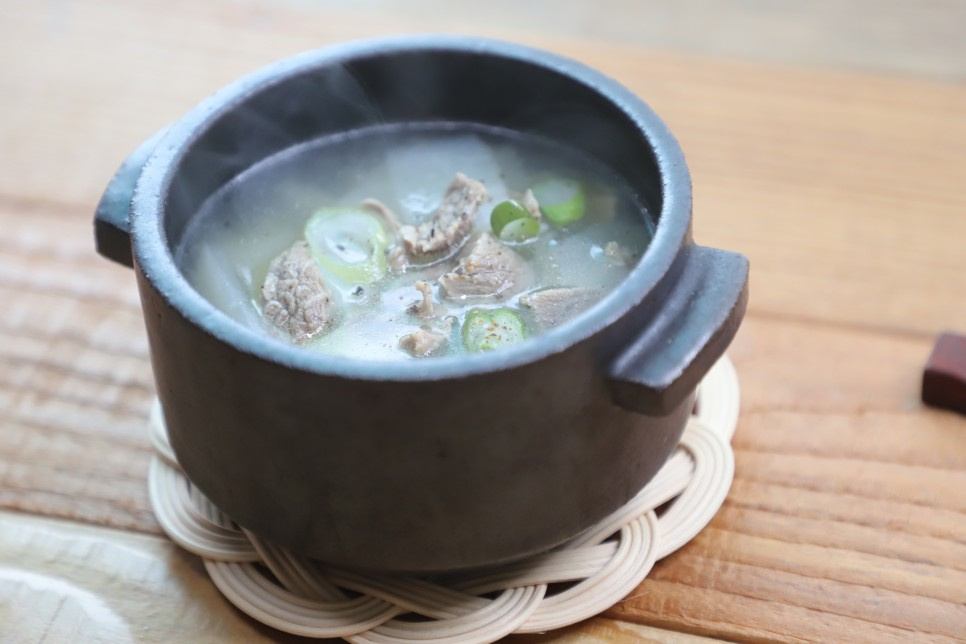Clear Korean Beef and Radish Soup (Sogogi Muguk)
How to Make Clear Korean Beef and Radish Soup: The Secret to a Refreshing and Flavorful Broth

Introducing a classic Korean home-style dish: Clear Korean Beef and Radish Soup (Sogogi Muguk). This soup features tender beef and sweet radish, creating a deep, savory broth that’s refreshingly clean without being greasy. It’s perfect as a palate cleanser, a comforting soup for any meal, or even as a hangover remedy. This recipe provides detailed steps, making it easy for beginners to follow.
Main Ingredients- 200g Beef brisket or stew meat
- 5 sheets Dried kelp (Dasima)
- 1/5 Korean radish (Mu, approx. 200-250g)
- 1 stalk Green onion (Scallion)
Seasonings & Others- 1 Tbsp Minced garlic
- 3 Tbsp Cooking wine (Mirin or similar)
- 2 Tbsp Soy sauce for soup (Gukganjang) or light soy sauce
- Pinch of Black pepper
- 1 Tbsp Minced garlic
- 3 Tbsp Cooking wine (Mirin or similar)
- 2 Tbsp Soy sauce for soup (Gukganjang) or light soy sauce
- Pinch of Black pepper
Cooking Instructions
Step 1
First, prepare the beef. Soak the 200g of beef brisket or stew meat in cold water for about 30 minutes to remove any blood. Thoroughly draining the blood will result in a cleaner broth and reduce any gamey odor from the meat.

Step 2
Peel the Korean radish and slice it thinly, about 0.5cm thick, into rectangular pieces. This ‘nabak-seolgi’ (thin slicing) allows the radish to cook tenderly and release its sweetness into the broth.

Step 3
Once the blood is drained, cut the beef against the grain into bite-sized pieces, about 0.5cm thick. Avoid slicing it too thinly, as it might break apart during cooking.

Step 4
In a pan or pot, add the sliced beef and just enough water to cover the bottom. Blanch the beef lightly until the surface changes color, before the water comes to a rolling boil. Drain the water, rinse the beef under cold running water to remove any remaining blood or impurities. (This step is recommended for those who prefer a very clean broth. If you want a richer beef flavor, you can skip this step. Choose based on your preference.)

Step 5
Now, let’s make the broth. In a pot, combine the blanched and rinsed beef, 1 liter of cold water, and the 5 sheets of dried kelp. Add 3 tablespoons of cooking wine (like Mirin) at this stage to help eliminate any beef odor.

Step 6
Once the water comes to a boil, continue to simmer for about 10 minutes to allow the kelp to infuse its umami flavor into the broth. After 10 minutes, remove and discard the kelp. Boiling kelp for too long can make the broth slimy or bitter.

Step 7
Even after blanching the beef, some impurities might rise to the surface. Skim off any foam or scum that appears during simmering. This will ensure a clear and refreshing broth.

Step 8
After removing the kelp, add the sliced Korean radish to the pot. Continue to boil for about 15 more minutes, or until the radish becomes tender. Ensure the radish is cooked through so its natural sweetness is fully released into the soup.

Step 9
Now it’s time to season. Stir in 1 tablespoon of minced garlic, 2 tablespoons of soy sauce for soup (or light soy sauce), and a pinch of black pepper. Using soy sauce for soup (Gukganjang) or a light-colored soy sauce will keep the broth clear and visually appealing. If you don’t have Gukganjang, regular soy sauce works too. You can also mix soy sauce with a little salt to achieve your desired taste.

Step 10
Check if all ingredients are cooked to perfection. The radish should be soft when pierced with a fork, and the beef should be tender. The broth should be clear yet opaque, indicating a rich flavor.

Step 11
Just before turning off the heat, add the diagonally sliced green onions. Adding them at the end preserves their fresh aroma, enhancing the overall taste of the soup.

Step 12
And there you have it – a delicious Sogogi Muguk! The broth is wonderfully clean and refreshing, without any trace of beefy odor. The tender radish, infused with the savory broth, melts in your mouth with a delightful sweetness. Enjoy this hearty and satisfying meal with a bowl of rice!



